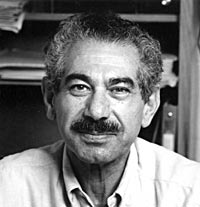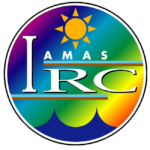
Julius London
1917-2009
Julius London, an outstanding contributor to the atmospheric sciences, a former chair of the Astrophysical and Planetary Sciences (APS) Department at the University of Colorado, and a Fellow of AMS, died in his sleep on 25 February 2009, just one month shy of his 92nd birthday. His broad research and teaching career covered meteorology and climatology, with major foci in radiation science, atmospheric ozone, cloud climatology, and solar-climate studies.
Julius, or Julie, as he preferred to be called, was born on 26 March 1917 in Newark, New Jersey. He earned his B.A. in mathematics from Brooklyn College in 1941 and his Ph.D. in meteorology and oceanography from New York University in 1951. During his graduate school days at New York University, Julie taught meteorology courses for the U.S. Air Force in support of War World II efforts. Also while a graduate student, he met his wife Dorothy Sibulsky, and it was love at first sight, or should we say love at their first bridge game. Only six weeks after this fortuitous meeting in a bridge game, they were wed on 6 July 1946 in Chicago.
Julie stayed on as a professor at New York University. But his love for Boulder grew quickly after visiting the University of Colorado (CU) during the summer of 1955. He and his family, including their sons David and Richard, visited Boulder every summer thereafter. They moved to Boulder in 1961 when Julie accepted a professorship in the new Department of Astro-Geophysics at CU, now the Astrophysical and Planetary Sciences Department. He remained at CU for the rest of his career and was chair of the department from 1966 to 1969. Although he retired as professor in 1987, he remained very active well into the late 1990s as professor emeritus at CU.
Julie and Dorothy loved to travel. They spent three sabbaticals at the Federal Institute of Technology in Zurich, where Julie was a visiting professor. He was also visiting professor/lecturer at Columbia University, Pennsylvania State University, the Chinese Academy of Science in Beijing, and Commonwealth Scientific and Industrial Research Organisation in Melbourne, Australia.
He attended and helped organize many international conferences and workshops. He was particularly active in the symposia of the International Radiation Commission and the International Ozone Commission, and the meetings of COSPAR, IAMAS, and the IUGG. Julie and Dorothy were regular fixtures at these international meetings and were well known and liked by all, with whom they shared and enjoyed many social experiences. They loved to dine out, and Julie was usually the first one at a conference to identify the best Chinese restaurant in town.
Julie had over 100 papers ranging from forecasting tropical cyclones to stratospheric ozone and temperature responses to solar ultraviolet variations. During his tenure at New York University in the 1950s, his research focused on calculations of the radiation budget of the atmosphere and the atmospheric heat balance. To make the radiation calculations, Julie had to construct a cloud climatology, which he did by analyzing surface synoptic observations of clouds. The resulting zonally and seasonally averaged cloud climatology was included in his report on the atmospheric heat balance. As interest in the Earth’s radiation budget and cloud climatology took off with the expanding field of climate research and the introduction of satellites to measure the radiation budget and clouds, this 1957 report – although never published in a scientific journal – accumulated 125 citations, including one as recently as 2003, had to be reprinted several times, and became a classic in the field. At NYU, he developed a course in theoretical climatology that emphasized the physical basis of climate at a time when most climatology courses were purely descriptive in nature.
At CU, Julie continued his work on atmospheric radiation. With a number of different collaborators, he published papers on a broad range of topics, including the radiation budget of the Southern Hemisphere, infrared radiative cooling of the mesosphere, and the decay of temperature perturbation by thermal radiation. Although his work on atmospheric ozone dates back to a report he coauthored while still at NYU, his major contributions to ozone research evolved at CU. Again working with a varied list of colleagues, he made significant contributions to our knowledge of ozone climatology, ozone photochemistry and radiative heating, atmospheric dynamics and ozone, and solar variations and ozone. He continued his early work on cloud climatology by teaming up with Steve Warren and Carol Hahn to produce a series of important papers on the global distribution of different cloud types based on analyses of cloud observations made by observers at weather stations and ships. With clouds as one of the central problems in climate change, the cloud climatologies developed by Julie and his colleagues – along with the satellite-based data of the International Satellite Cloud Climatology Project (ISCCP) – continue to serve as a valuable tool to validate climate model simulations.
During the later half of his career, Julie worked on several NASA satellite programs, such as the Solar Mesosphere Explorer, the Upper Atmosphere Research Satellite, and the Solar Radiation and Climate Experiment. Several of his early papers in the 1950s were about solar influence on climate changes at the surface, so Julie can be considered one of the founding fathers of sun-climate studies.
Among many honors received during his career are the CU Medal in 1987 and an Honorary Doctorate from ETH in 1991.
Julie unselfishly gave to the global science community in many ways. He served as editor for several journals including Journal of Geophysical Research, Weatherwise, Contributions to Atmospheric Physics, Arctic and Alpine Research, and international journals Il Nuevo Cimento C, Geofisica Internacional, Advances in Atmospheric Sciences,and Atmosfera.As can be seen again, he had a very international lifestyle in his science pursuits.
Julie was also involved in many professional societies, most notably in the International Radiation Commission (IRC) and International Ozone Commission (IOC). He served continuously for the IRC beginning in 1963, initially as secretary (1963-71), then President (1971-79), and as honorary member through 2008. His exceptional leadership for the IRC led the commission into the age of global research programs and promoted the cooperation with COSPAR to build up a global satellite observing system and to develop appropriate calibration and evaluation methods of the data measured in space. He made many friends in the East and West and brought scientists from both sides to the IRC meetings to work effectively together, which was not self-evident at that time when the world was politically split. He was a member of the IOC from 1959 to 1980 and was elected an honorary member in 1984.
Julie was always excited about teaching science and discussing the science issues with so many of us. Many of his friends and family members, including granddaughters Shoshana and Anna, recall how Julie would stop during a hike and explain the physics of the specific clouds overhead. Even though his hearing and eyesight was failing, he was still making contributions in 2008 to a paper about the IRC history, which we hope to submit for publication soon.
Julie was preceded in death by his wife Dorothy and son David, and is survived by his son Richard. We will miss our good friend and stimulating colleague. – Tom Woods, Robert Cahalan, Gary Rottman, and George Ohring.
